Yongjune Kim
Collaborative Edge-to-Server Inference for Vision-Language Models
Dec 18, 2025Abstract:We propose a collaborative edge-to-server inference framework for vision-language models (VLMs) that reduces the communication cost while maintaining inference accuracy. In typical deployments, visual data captured at edge devices (clients) is transmitted to the server for VLM inference. However, resizing the original image (global image) to match the vision encoder's input resolution often discards fine-grained details, leading to accuracy degradation. To overcome this limitation, we design a two-stage framework. In the first stage, the server performs inference on the global image and identifies a region of interest (RoI) using the VLM's internal attention. The min-entropy of the output tokens is then computed as a confidence measure to determine whether retransmission is required. If the min-entropy exceeds a predefined threshold, the server requests the edge device to send a detail-preserved local image of the RoI. The server then refines its inference by jointly leveraging the global and local images. This selective retransmission strategy ensures that only essential visual content is transmitted. Experiments across multiple VLM architectures show that the proposed framework significantly reduces communication cost while maintaining inference accuracy.
Code-Weight Sphere Decoding
Aug 28, 2025Abstract:Ultra-reliable low-latency communications (URLLC) demand high-performance error-correcting codes and decoders in the finite blocklength regime. This letter introduces a novel two-stage near-maximum likelihood (near-ML) decoding framework applicable to any linear block code. Our approach first employs a low-complexity initial decoder. If this initial stage fails a cyclic redundancy check, it triggers a second stage: the proposed code-weight sphere decoding (WSD). WSD iteratively refines the codeword estimate by exploring a localized sphere of candidates constructed from pre-computed low-weight codewords. This strategy adaptively minimizes computational overhead at high signal-to-noise ratios while achieving near-ML performance, especially for low-rate codes. Extensive simulations demonstrate that our two-stage decoder provides an excellent trade-off between decoding reliability and complexity, establishing it as a promising solution for next-generation URLLC systems.
Robust Deep Joint Source Channel Coding for Task-Oriented Semantic Communications
Mar 17, 2025Abstract:Semantic communications based on deep joint source-channel coding (JSCC) aim to improve communication efficiency by transmitting only task-relevant information. However, ensuring robustness to the stochasticity of communication channels remains a key challenge in learning-based JSCC. In this paper, we propose a novel regularization technique for learning-based JSCC to enhance robustness against channel noise. The proposed method utilizes the Kullback-Leibler (KL) divergence as a regularizer term in the training loss, measuring the discrepancy between two posterior distributions: one under noisy channel conditions (noisy posterior) and one for a noise-free system (noise-free posterior). Reducing this KL divergence mitigates the impact of channel noise on task performance by keeping the noisy posterior close to the noise-free posterior. We further show that the expectation of the KL divergence given the encoded representation can be analytically approximated using the Fisher information matrix and the covariance matrix of the channel noise. Notably, the proposed regularization is architecture-agnostic, making it broadly applicable to general semantic communication systems over noisy channels. Our experimental results validate that the proposed regularization consistently improves task performance across diverse semantic communication systems and channel conditions.
Vision Transformer-based Semantic Communications With Importance-Aware Quantization
Dec 08, 2024Abstract:Semantic communications provide significant performance gains over traditional communications by transmitting task-relevant semantic features through wireless channels. However, most existing studies rely on end-to-end (E2E) training of neural-type encoders and decoders to ensure effective transmission of these semantic features. To enable semantic communications without relying on E2E training, this paper presents a vision transformer (ViT)-based semantic communication system with importance-aware quantization (IAQ) for wireless image transmission. The core idea of the presented system is to leverage the attention scores of a pretrained ViT model to quantify the importance levels of image patches. Based on this idea, our IAQ framework assigns different quantization bits to image patches based on their importance levels. This is achieved by formulating a weighted quantization error minimization problem, where the weight is set to be an increasing function of the attention score. Then, an optimal incremental allocation method and a low-complexity water-filling method are devised to solve the formulated problem. Our framework is further extended for realistic digital communication systems by modifying the bit allocation problem and the corresponding allocation methods based on an equivalent binary symmetric channel (BSC) model. Simulations on single-view and multi-view image classification tasks show that our IAQ framework outperforms conventional image compression methods in both error-free and realistic communication scenarios.
Neural Window Decoder for SC-LDPC Codes
Nov 28, 2024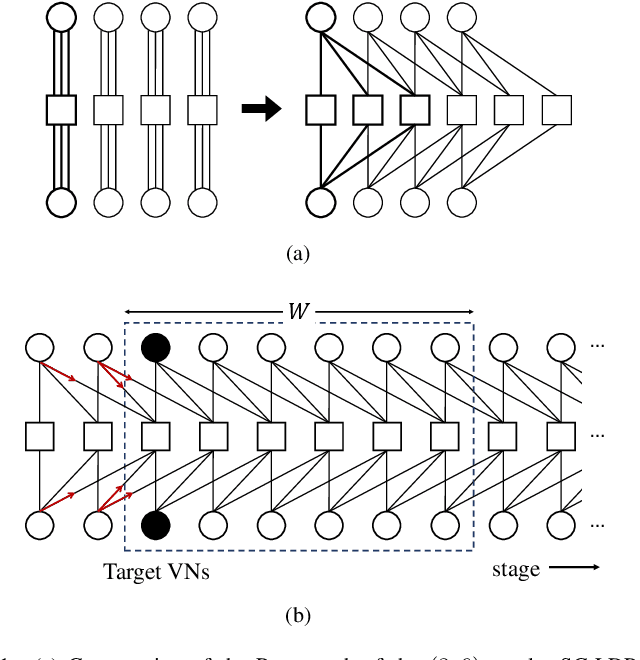
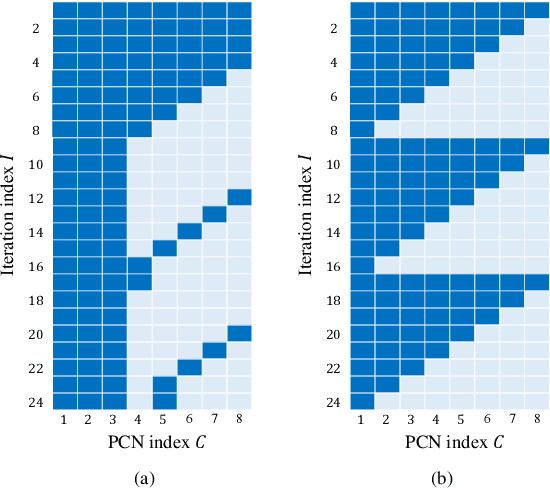

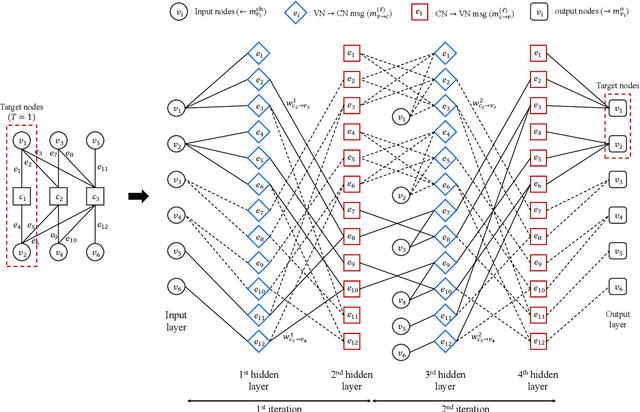
Abstract:In this paper, we propose a neural window decoder (NWD) for spatially coupled low-density parity-check (SC-LDPC) codes. The proposed NWD retains the conventional window decoder (WD) process but incorporates trainable neural weights. To train the weights of NWD, we introduce two novel training strategies. First, we restrict the loss function to target variable nodes (VNs) of the window, which prunes the neural network and accordingly enhances training efficiency. Second, we employ the active learning technique with a normalized loss term to prevent the training process from biasing toward specific training regions. Next, we develop a systematic method to derive non-uniform schedules for the NWD based on the training results. We introduce trainable damping factors that reflect the relative importance of check node (CN) updates. By skipping updates with less importance, we can omit $\mathbf{41\%}$ of CN updates without performance degradation compared to the conventional WD. Lastly, we address the error propagation problem inherent in SC-LDPC codes by deploying a complementary weight set, which is activated when an error is detected in the previous window. This adaptive decoding strategy effectively mitigates error propagation without requiring modifications to the code and decoder structures.
Boosted Neural Decoders: Achieving Extreme Reliability of LDPC Codes for 6G Networks
May 22, 2024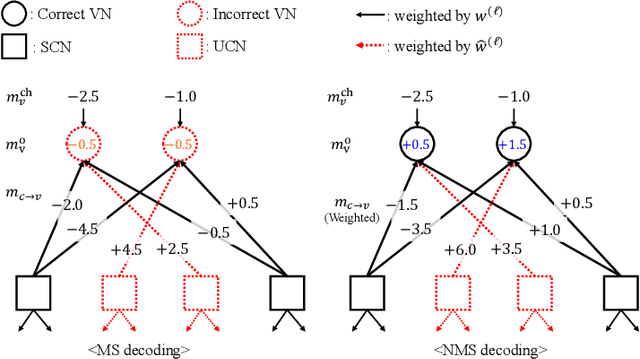
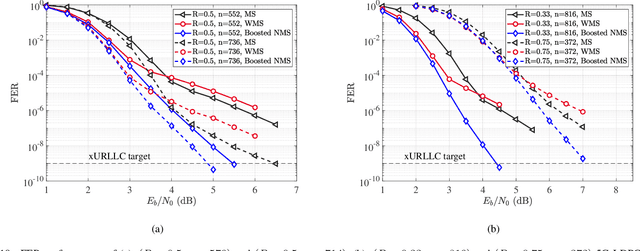
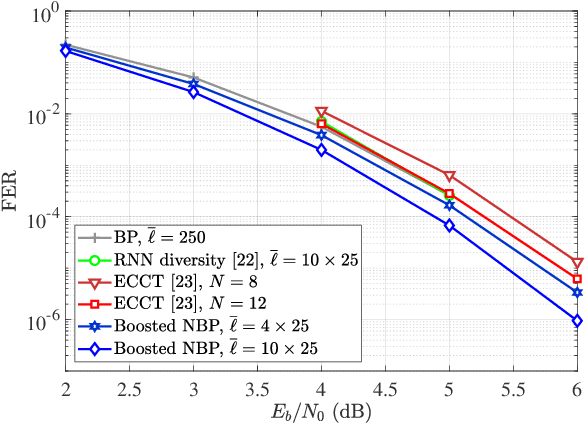
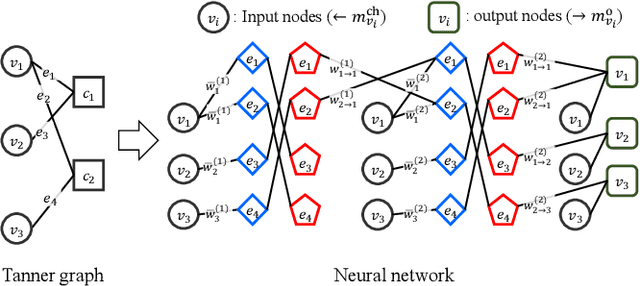
Abstract:Ensuring extremely high reliability is essential for channel coding in 6G networks. The next-generation of ultra-reliable and low-latency communications (xURLLC) scenario within 6G networks requires a frame error rate (FER) below 10-9. However, low-density parity-check (LDPC) codes, the standard in 5G new radio (NR), encounter a challenge known as the error floor phenomenon, which hinders to achieve such low rates. To tackle this problem, we introduce an innovative solution: boosted neural min-sum (NMS) decoder. This decoder operates identically to conventional NMS decoders, but is trained by novel training methods including: i) boosting learning with uncorrected vectors, ii) block-wise training schedule to address the vanishing gradient issue, iii) dynamic weight sharing to minimize the number of trainable weights, iv) transfer learning to reduce the required sample count, and v) data augmentation to expedite the sampling process. Leveraging these training strategies, the boosted NMS decoder achieves the state-of-the art performance in reducing the error floor as well as superior waterfall performance. Remarkably, we fulfill the 6G xURLLC requirement for 5G LDPC codes without the severe error floor. Additionally, the boosted NMS decoder, once its weights are trained, can perform decoding without additional modules, making it highly practical for immediate application.
CrossMPT: Cross-attention Message-Passing Transformer for Error Correcting Codes
May 02, 2024



Abstract:Error correcting codes~(ECCs) are indispensable for reliable transmission in communication systems. The recent advancements in deep learning have catalyzed the exploration of ECC decoders based on neural networks. Among these, transformer-based neural decoders have achieved state-of-the-art decoding performance. In this paper, we propose a novel Cross-attention Message-Passing Transformer~(CrossMPT). CrossMPT iteratively updates two types of input vectors (i.e., magnitude and syndrome vectors) using two masked cross-attention blocks. The mask matrices in these cross-attention blocks are determined by the code's parity-check matrix that delineates the relationship between magnitude and syndrome vectors. Our experimental results show that CrossMPT significantly outperforms existing neural network-based decoders, particularly in decoding low-density parity-check codes. Notably, CrossMPT also achieves a significant reduction in computational complexity, achieving over a 50\% decrease in its attention layers compared to the original transformer-based decoder, while retaining the computational complexity of the remaining layers.
Optimizing Layerwise Polynomial Approximation for Efficient Private Inference on Fully Homomorphic Encryption: A Dynamic Programming Approach
Oct 16, 2023Abstract:Recent research has explored the implementation of privacy-preserving deep neural networks solely using fully homomorphic encryption. However, its practicality has been limited because of prolonged inference times. When using a pre-trained model without retraining, a major factor contributing to these prolonged inference times is the high-degree polynomial approximation of activation functions such as the ReLU function. The high-degree approximation consumes a substantial amount of homomorphic computational resources, resulting in slower inference. Unlike the previous works approximating activation functions uniformly and conservatively, this paper presents a \emph{layerwise} degree optimization of activation functions to aggressively reduce the inference time while maintaining classification accuracy by taking into account the characteristics of each layer. Instead of the minimax approximation commonly used in state-of-the-art private inference models, we employ the weighted least squares approximation method with the input distributions of activation functions. Then, we obtain the layerwise optimized degrees for activation functions through the \emph{dynamic programming} algorithm, considering how each layer's approximation error affects the classification accuracy of the deep neural network. Furthermore, we propose modulating the ciphertext moduli-chain layerwise to reduce the inference time. By these proposed layerwise optimization methods, we can reduce inference times for the ResNet-20 model and the ResNet-32 model by 3.44 times and 3.16 times, respectively, in comparison to the prior implementations employing uniform degree polynomials and a consistent ciphertext modulus.
Boosting Learning for LDPC Codes to Improve the Error-Floor Performance
Oct 11, 2023
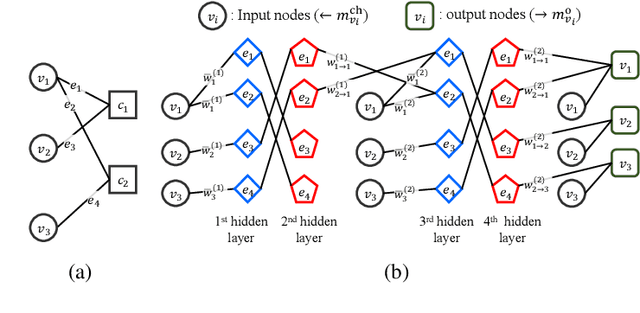


Abstract:Low-density parity-check (LDPC) codes have been successfully commercialized in communication systems due to their strong error correction ability and simple decoding process. However, the error-floor phenomenon of LDPC codes, in which the error rate stops decreasing rapidly at a certain level, poses challenges in achieving extremely low error rates and the application of LDPC codes in scenarios demanding ultra high reliability. In this work, we propose training methods to optimize neural min-sum (NMS) decoders that are robust to the error-floor. Firstly, by leveraging the boosting learning technique of ensemble networks, we divide the decoding network into two networks and train the post network to be specialized for uncorrected codewords that failed in the first network. Secondly, to address the vanishing gradient issue in training, we introduce a block-wise training schedule that locally trains a block of weights while retraining the preceding block. Lastly, we show that assigning different weights to unsatisfied check nodes effectively lowers the error-floor with a minimal number of weights. By applying these training methods to standard LDPC codes, we achieve the best error-floor performance compared to other decoding methods. The proposed NMS decoder, optimized solely through novel training methods without additional modules, can be implemented into current LDPC decoders without incurring extra hardware costs. The source code is available at https://github.com/ghy1228/LDPC_Error_Floor.
How to Mask in Error Correction Code Transformer: Systematic and Double Masking
Aug 25, 2023Abstract:In communication and storage systems, error correction codes (ECCs) are pivotal in ensuring data reliability. As deep learning's applicability has broadened across diverse domains, there is a growing research focus on neural network-based decoders that outperform traditional decoding algorithms. Among these neural decoders, Error Correction Code Transformer (ECCT) has achieved the state-of-the-art performance, outperforming other methods by large margins. To further enhance the performance of ECCT, we propose two novel methods. First, leveraging the systematic encoding technique of ECCs, we introduce a new masking matrix for ECCT, aiming to improve the performance and reduce the computational complexity. Second, we propose a novel transformer architecture of ECCT called a double-masked ECCT. This architecture employs two different mask matrices in a parallel manner to learn more diverse features of the relationship between codeword bits in the masked self-attention blocks. Extensive simulation results show that the proposed double-masked ECCT outperforms the conventional ECCT, achieving the state-of-the-art decoding performance with significant margins.
 Add to Chrome
Add to Chrome Add to Firefox
Add to Firefox Add to Edge
Add to Edge